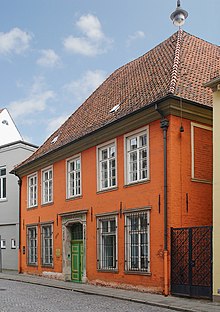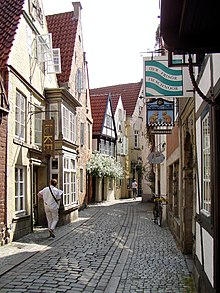Preservation of monuments in Bremen


The preservation of monuments in Bremen protects, maintains, maintains and researches the cultural monuments . These include buildings, building ensembles , art monuments , garden monuments , archaeological monuments and technical installations of public interest are under legal conservation resource (see: Monument Protection Act ).
The preservation of monuments documents the cultural monuments of the history of Bremen and Bremerhaven .
Cultural monuments create identity as the past made material . Cultural monuments must be restored or maintained by their respective owners. State grants are only possible to a limited extent and for special measures.
Cultural monuments in Bremen
In the state of Bremen , cultural monuments are under protection in 1924 (as of April 25, 2012).
In Bremen-Stadt there were 1487 monuments (as of 2008), of which in the districts:
- Mitte 554 (including Altstadt 200, Bahnhofsvorstadt 9, Ostertor 345), Blockland 2, Blumenthal 22, Borgfeld 2, Burglesum 39, Findorff 7, Gröpelingen 60, Häfen 13, Hemelingen 13, Horn-Lehe 18, Huchting 3, Neustadt 50, Oberneuland 38, Obervieland 7, Ostliche Vorstadt 290 (including Fesenfeld 207), Osterholz 32, Schwachhausen 245 (including Bürgerpark 87), Seehausen 2, Vahr 6, Vegesack 64, Walle 15 and Woltmershausen 5.
There were 145 monuments in Bremerhaven (as of 2008), of which in the districts:
- Geestemünde 12, Häfen 6, Lehe 82, Mitte 37, Weddewarden 4 and Wulsdorf 4.
There are particularly significant monuments on and on the
- Places: Bremen marketplace with the Bremen Town Hall and the Roland as a World Heritage of UNESCO , Domshof , Domsheide , Our Loves Women Cemetery and Ansgarikirchhof
- Streets: Böttcherstraße , Langenstraße , Obernstraße , Sögestraße , Schlachte
- City quarters: Schnoor , Bürgerpark
- General: The Bremen House
- Bremerhaven: Technical monuments such as the lighthouses / beacon " New Harbor ", at the Kaiserschleuse , on the Geestemole and the north pier, light beacon Willy-Brandt-Platz, water level indicator, bascule bridge between the old and new port , north lock , old Geestebrücke , water tower Lehe and the German Maritime Museum with the fleet
- Bremerhaven: Great Church / Mayor Smidt Memorial Church , Dionysius Church Bremerhaven-Lehe Lange Straße, Dionysius Church Wulsdorf , the oldest church in Bremerhaven
history
In the 19th century, state preservation of monuments was introduced in the public interest. For this, full-time or part-time conservators were employed and monument offices were established. From 1861 there was a section for the preservation of Bremen antiquities in the Kunstverein in Bremen . In 1892 the Senate set up a commission for the preservation of art and cultural historical monuments . In 1909 the law on the protection of architectural monuments was passed. The first list of monuments was drawn up. The monument preservation issues were taken care of by the building authorities.
It was not until 1933 that a conservator could be appointed in Bremen. The first state curator was Dr. Ernst Grohne . Gustav Ulrich was the monument conservator from 1945 to 1952 . He was followed in 1952 by Dr. Werner Kloos . Grohne and Kloos were also directors of the Focke Museum . It was followed by Dr. Rudolf Stein and Karl Dillschneider .
From 1945 to 1971 there was also the municipal office for the preservation of monuments. In 1972 the State Office for Monument Preservation was founded, in which the tasks of the state and the city were brought together. Head of the central monument authority and state conservator was Dr. Hans-Christoph Hoffmann. In 2001 he was followed by Dr. Georg Skalecki .
In 2010, the Bremen Monument Preservation Prize was awarded for the first time under the patronage of the President of the Senate .
Advice and support
In Germany, monument preservation and monument protection fall under the cultural sovereignty of the federal states . In Bremen, cultural monuments are " inventoried " by the responsible offices and summarized in monument lists as legally binding protection.
The following are responsible for the technical approval, support and advice of restoration projects:
- State Office for the Preservation of Monuments, the State Conservator
- Monument protection authority Bremerhaven: Magistrate of the city of Bremerhaven, building regulations office
The general concerns are dealt with in a senatorial authority:
- Upper monument protection authority: Senator for Culture
All of the more than 1,600 cultural monuments of the state of Bremen are presented in words and pictures in a database.
See also
- State Office for Monument Preservation Bremen
- List of cultural monuments in Bremen
- List of cultural monuments in Bremerhaven
- Bremen monuments
- Monument protection
- List of monuments
literature
-
Gottfried Kiesow : Monument preservation in Germany. An introduction . 4th, revised edition, Wissenschaftliche Buchgesellschaft, Darmstadt 2000.
(1st edition 1982; 2nd, improved edition 1989; 3rd, unchanged edition 1995) - Uta Halle : Archaeological research in Bremen and around. In: Uta Halle, Claus von Carnap-Bornheim (Hrsg.): Bremen and umzu. Excursion destinations on the dune, Geest and in the marsh. (= Excursions to archeology, history and culture in Germany , Volume 53.) Theiss-Verlag, Stuttgart 2011, ISBN 978-3-8062-2562-4 , pp. 25–33.
- Sandra Geringer, Dirk Mahsarski: Ernst Grohne and his excavations. An example from Bremen. In: Focke-Museum (Ed.): Trench for Germania. Archeology under the swastika. Theiss-Verlag, Stuttgart 2013, ISBN 978-3-8062-2673-7 , pp. 74-81.
Web links
- The State Office for the Preservation of Historic Monuments in Bremen has information on the listed buildings in Bremen and Bremerhaven :
- The current list of monuments of the state of Bremen can be called up digitally under Monument .
- Monument database , online database
- The web links to Commons can be found in the respective lists of cultural monuments in Bremen and Bremerhaven listed under “See also”.


